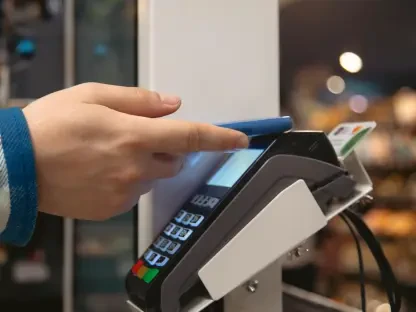Retailers nationwide are ringing in the new year grappling with prevailing concerns about theft and merchandise loss. The National Retail Federation (NRF) recently illuminated this issue in a broad survey of loss prevention and security executives from 164 mid to large-sized retailers. A significant takeaway is the overwhelming consensus that organized retail crime, shoplifting, return fraud, repeat offenses, and theft linked to in-store pickup or return of online orders have escalated compared to the previous year.
Key Points and Trends
Escalation of Retail Crime
Despite the industry’s ongoing efforts, measuring the exact impact of these criminal activities on retailers remains a challenge, shrouded in uncertainty regarding the accuracy of available data. The NRF’s claims on merchandise shrink attributed to organized retail crime faced scrutiny in 2023 when a major flaw was discovered in their estimation method. As a result, they retracted their statement and ceased publication of the annual shrink report in 2024, a report which had been a cornerstone for over 30 years.
The NRF’s research, predominantly based on executive surveys rather than hard data like law enforcement reports, underlines a 26% rise in shoplifting from 2022 to 2023. Additionally, it highlights a staggering 93% increase in both the average number of shoplifting incidents and the dollar loss from 2019 to 2023. Interestingly, this figure coincides with findings from the National Incident-Based Reporting System (NIBRS), which also reported a 93% increase in shoplifting rates over the same period.
Discrepancies in Reporting
However, the more established Summary Reporting System (SRS) does not reflect this spike, showing steady shoplifting rates between 2019 and 2023, emphasizing the potential overstatement of rising crime rates due to the ongoing addition of new data sources in the NIBRS. A more recent update from the Council on Criminal Justice (CCJ) found a 14% rise in the average reported shoplifting rate in 2024, translating to a 1% rise over five years. This potentially points to underreporting by retailers to law enforcement, reinforcing the need for more reliable data. The discrepancies in reporting methods and data collection have created a complex landscape for retailers who are attempting to develop effective loss prevention strategies based on inaccurate information.
Focus on Violent Incidents
Surge in Aggressive Behavior
A particularly disturbing trend is the surge in violence associated with retail theft. More than 70% of surveyed retailers reported an uptick in aggressive and violent behavior from shoplifters compared to the previous year, with more than 90% noting a significant increase since 2019. This escalation in dangerous behavior adds another layer of complexity to theft prevention and highlights the need for enhanced security measures.
The increase in aggressive behavior during theft incidents poses substantial risks to both employees and customers, necessitating more sophisticated approaches to store security. Retailers are now compelled to invest in advanced training programs for staff, equipping them with the skills to handle confrontational situations effectively. Additionally, the installation of more sophisticated surveillance systems and hiring professional security personnel are becoming integral parts of the retailer’s updated security protocols.
Impact on Loss Prevention Strategies
The conversation around shrink extends beyond just theft. The NRF’s reevaluation of its research methodology coincides with several retailers reporting improvements in merchandise loss following operational tweaks. Yet, an accurate assessment of how much inventory is genuinely lost to crime remains elusive. Adhering to the retail inventory method, which calculates ending inventory value based on price, may overestimate shrink levels. Adopting a cost method of accounting might provide a clearer picture.
Retailers are increasingly looking at broader strategies to mitigate losses, including leveraging data analytics to better understand shrink trends and developing more effective prevention measures. There is a growing emphasis on identifying and mitigating all potential sources of loss. This includes administrative errors, supplier fraud, and damage during shipping, which may have been previously overlooked. Retailers also recognize the importance of a holistic approach, integrating various departments such as logistics, inventory management, and workforce training into their overall loss prevention strategy.
Reevaluating Shrink and Loss Prevention Strategies
Identifying Overlooked Sources of Shrink
According to Brand Elverston, a notable loss prevention expert, the oversized focus on theft might miss other significant sources of shrink that have been historically underappreciated. Johnny Custer, another loss prevention authority, advocates for a more integrated approach, promoting seamless collaboration between store operations and loss prevention teams. Such coordination transforms loss prevention into a proactive asset and profit protection strategy, transcending beyond mere crime prevention.
Elverston’s insights emphasize the importance of diversifying focus—understanding that while theft is a prominent issue, there are various other leaks in the system that contribute to overall shrink. These can be as mundane as pricing errors, stock mismanagement, or even operational inefficiencies. By adopting a multi-faceted point of view, retailers can address the more granulated issues that collectively lead to substantial losses. Furthermore, fostering a culture of accountability and precision within the retailer’s operational framework can significantly reduce non-theft related shrink.
Adapting Loss Prevention Tactics
Retailers are employing various tactics to mitigate theft and manage shrinkage, many of which require reconsideration and adaptation. These strategies are not static but are continually evolving in response to new challenges and technologies.
The implementation of advanced technologies such as AI-driven surveillance and predictive analytics is on the rise. These systems can identify patterns and anomalies that might indicate security breaches or operational inefficiencies. They provide actionable insights that enable retailers to preemptively address potential threats before they manifest into significant problems. Additionally, integrating loss prevention tactics with broader business strategies—such as customer engagement and service excellence—can create an environment where assets are protected, and customers feel valued.
Locked-Up Merchandise
Balancing Deterrence and Customer Experience
One common tactic to deter theft has been locking up high-theft items. However, this strategy presents a double-edged sword: while it deters thieves, it also frustrates genuine customers. A Numerator study revealed that over 25% of shoppers encountering locked cases would walk away instead of waiting for assistance. In response, retailers like CVS Health are experimenting with unlocking merchandise through their apps to enhance customer convenience. Similarly, Walgreens is exploring innovative measures to balance shrink control and customer experience.
For instance, some retailers are experimenting with portable electronic lock systems that can be remotely controlled via an app, offering a seamless shopping experience without compromising security. These systems allow high-risk items to remain accessible to the customer while ensuring that only genuine buyers can unlock them. This approach minimizes customer frustration and maintains the convenience and speed of shopping, which is critical in retaining customer loyalty.
Innovations in Merchandise Security
Retailers are continuously seeking innovative solutions to address the challenges posed by locked-up merchandise. By leveraging technology and improving customer service, they aim to create a more seamless shopping experience while effectively deterring theft.
In addition to app-based solutions, some retailers are integrating smart shelves that track when items are picked up and not replaced within a certain timeframe. These shelves can alert store associates to suspicious activity, allowing for immediate intervention if necessary. Other innovations include invisible tagging systems that blend into packaging but trigger alarms if removed from the store without deactivation. These advanced security measures represent the next frontier in loss prevention, marrying technology with customer-centric solutions.
Self-Checkout Challenges
Contribution to Retail Shrinkage
Self-checkout has emerged as a significant factor in retail shrinkage, often surpassing losses from organized retail crime. Research from the University of Leicester indicates that self-checkout lanes contribute to 20-25% of unknown store losses in the U.S. Initially seen as a labor-saving tool, many retailers now find that self-checkouts need adequate staffing to function optimally and reduce shrink. Consequently, some retailers are scaling back or completely removing self-checkout kiosks. For instance, Dollar General has begun limiting self-service checkouts, reporting a notable decrease in merchandise loss shortly after the shift.
Current strategies to reduce self-checkout-related shrink include enhanced oversight, real-time video monitoring, and weight verification systems to validate that scanned items match those placed in the bagging area. Intuitive design changes are also being implemented to minimize user error and confusion, thus reducing opportunities for theft. Retailers are investing in better-trained staff who can provide on-the-spot assistance and deter potential shoplifters through their presence alone.
Innovations in Self-Checkout Security
Retailers are turning to technological innovations to address and mitigate the identified challenges in self-checkout systems. By using advanced software solutions and artificial intelligence, companies can now better monitor and analyze customer behavior at self-checkout kiosks. This technological approach not only helps in identifying suspicious patterns but can also integrate seamlessly within the customers’ shopping experiences.
Innovative solutions like biometric verification, where fingerprints or facial recognition can be used to authenticate transactions, are also making their way into self-checkouts. Integrating these measures ensures that only the intended user completes the transaction, significantly reducing the likelihood of “scan-and-skip” incidents. These advancements contribute to a more secure self-checkout process, supporting retailers in their ongoing efforts to balance efficiency and security.
Cargo Theft
Rising Concern in Supply Chain Security
Another rising concern is cargo theft, which includes various fraudulent activities at different points in the supply chain. Such crimes include tricking shippers, cyber theft, and altering shipment documentation to divert goods. According to the FBI, cargo theft saw unprecedented levels in 2024, with a significant increase in incidents reported across states like Texas and California. Nearly half of the NRF survey respondents acknowledged an increased concern regarding cargo theft last year, underscoring the need for better security measures within the supply chain.
The growing complexity of global supply chains requires retailers to adopt more sophisticated logistics and security solutions. This includes using real-time tracking systems, tamper-evident seals, and partnering with reputable logistics providers who adhere to stringent security protocols. Additionally, implementing risk assessment tools to analyze vulnerability points across the supply chain can help retailers develop more adaptive and responsive security strategies. The collaboration between retailers, logistics firms, and law enforcement agencies is crucial in effectively combating sophisticated cargo theft operations.
Innovative Security Solutions for Cargo
Retailers and logistics providers are increasingly leveraging technology to enhance supply chain security, mitigating the rising threat of cargo theft. Key developments include the adoption of blockchain technology, which provides an immutable ledger for tracking goods from origin to destination. This level of transparency not only deters illicit activities but also enables swift action if discrepancies or unauthorized diversions occur.
Advanced GPS tracking systems are also widely used, offering real-time updates on the location and status of shipments. This technology, coupled with geofencing, allows retailers to be immediately alerted if a shipment deviates from its intended route. Furthermore, artificial intelligence and machine learning algorithms are being employed to predict and identify potential theft-prone shipments based on historical data and current trends. These technologies provide invaluable insights, empowering retailers to take preemptive measures to safeguard their cargo.
Public Policy and Legislative Advocacy
Strengthening Legal Penalties and Support
Retail industry groups are pressing for enhanced law enforcement support and stricter legal penalties for theft and shoplifting. In California, voters passed Proposition 36 in November, a measure imposing stricter penalties for recurrent theft offenders, going further than a previously signed law. On a national level, initiatives like the Combating Organized Retail Crime Act of 2023 sought to channel federal resources to local and state efforts. While the bill stalled in the previous Congress, the NRF continues to push for federal legislation to help curb organized retail crime, with broad support from loss prevention and security executives.
The legislative landscape is crucial for shaping how effectively retailers can tackle theft and violence. Stronger penalties for repeat offenders not only serve as a deterrent but also provide retailers with legal recourse to address ongoing troubles more effectively. Grassroots efforts by the NRF and other industry stakeholders continue to lobby for these laws, underlining the pressing need for an updated legal framework that reflects the evolving nature of retail crime. Moreover, consistent advocacy aims to bring more awareness and resources to this critical issue at both state and federal levels.
Collaboration for Comprehensive Solutions
The NRF also seeks to leverage any supportive stance from the administration to implement tougher measures against retail crime, potentially providing significant relief from shrinkage. Experts like Chris Bottiglieri from BNP Paribas Exane speculate that a hard-line stance from the Trump administration could catalyze further measures to reduce shrink.
Public-private partnerships are being explored as a means to address retail theft comprehensively. By enabling direct cooperation between retailers, security experts, law enforcement, and policymakers, a more unified approach to combating shoplifting and organized retail crime can be developed. The goal is to create an environment where preventive measures, rapid response strategies, and stringent legal actions converge towards reducing the incidence of retail crime. Tailored advocacy efforts, reflecting the specific needs of various retail segments, also ensure that both small businesses and large retail chains benefit equally from new regulations and support systems.
Conclusion
As the new year begins, retailers across the country are dealing with rising concerns about theft and merchandise loss. These issues were highlighted in a comprehensive survey by the National Retail Federation (NRF), which gathered insights from loss prevention and security executives at 164 mid to large-sized retailers. The survey revealed a troubling trend: there is a clear and overwhelming consensus that various forms of theft have become more prevalent compared to the previous year. Organized retail crime, shoplifting, return fraud, and repeat offenses are on the rise. Additionally, theft associated with in-store pickup of online orders or the return of online purchases has also increased. Retailers are now compelled to find new methods and strategies to combat these growing challenges, ensuring not only the safety of their merchandise but also the protection of their bottom lines. This uptick in criminal activity is forcing retailers to be more vigilant and innovative in their loss prevention tactics, adjusting to the evolving landscape of retail crime to safeguard their operations and maintain customer trust.









